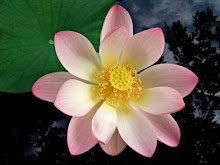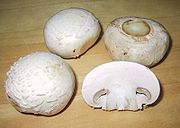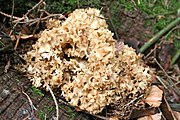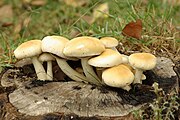Species
[edit] Ganoderma lucidum and Ganoderma tsugae (Reishi/Lingzhi)
Língzhī (Reishi Young-Ji, 灵芝, 영지) Chinese for "spirit plant" is the name for the mushroom Ganoderma lucidum. Several species of Ganoderma have been used in traditional Asian medicines for thousands of years. The medicinal effects of the mushroom are thought to be due to triterpenes like ganoderic acid, as well as beta-glucan compounds. The health benefits of reishi are described in Shen Nong's Herbal Classic and Pen T'sao Kang Mu ("Great Pharmacopoeia"). The Reishi mushroom is a symbol for health, and is depicted in the Emperor's residences in the Forbidden City as well as the Summer Palace. The Chinese goddess of healing Kuan Yin is sometimes depicted holding a Reishi mushroom. Modern scientific research examining the Ganoderma mushrooms has revealed a variety of potential health benefits:
- anti-cancer properties[35][36]
- immune system up-regulation[37][38]
- antioxidant activity[39][40]
- liver-protecting properties[41][42]
- hypoglycemic properties[43][44]
- antibacterial properties,[45] antiviral properties,[46][47] and antifungal properties[48]
- inhibiting synthesis of cholesterol,[49] as well as reducing blood cholesterol[50]
- reducing radiation-induced damage[51]
- reducing lower urinary tract symptoms[52]
- increasing exercise endurance[53]
- inhibitory effect on high blood pressure, due to ACE inhibitor properties.[54]
- inhibitory effects on angiogenesis (via inhibition of VEGF),[55] blood platelet creation,[56] and fibrosis.[57]
[edit] Trametes versicolor (Coriolus versicolor)
Trametes versicolor (Coriolus versicolor, Turkey tail, Kawaratake, Yun-Zhi, 云芝) is probably the best documented medicinal mushroom. It is a mushroom which has provided the world with a leading cancer drug. The drug is known as Polysaccharide-K (Kresin, PSK, PSP) and its use is intended to counter-act the immune system depressing actions of common chemotherapeutic drugs. In Japan, the Health and Welfare Ministry (equivalent to the United State's Food and Drug Administration) approved Polysaccharide-K in the 1980s.[58] All health care plans in Japan cover the use of Polysaccharide-K.
Used in conjunction with chemotherapy, PSK has increased the survival time of cancer patients in randomized, control studies, with the following types of cancer[59]
- Stomach cancer[60]
- Colorectal cancer[61]
- Small cell carcinoma of the lungs
- Non-small cell lung carcinoma[62]
The United State's top ranked[63] cancer hospital, the MD Anderson has reported that, Polysaccharide-K is a "promising candidate for chemoprevention due to the multiple effects on the malignant process, limited side effects and safety of daily oral doses for extended periods of time."[64]
[edit] Grifola frondosa (Maitake)
Maitake (Hen of the Woods) is an edible mushroom commonly found on oak trees. This year, a phase I/II human trial, conducted by Memorial Sloan–Kettering Cancer Center, showed Maitake could stimulate the immune systems of breast cancer patients.[10] Small experiments with human cancer patients, have shown Maitake can stimulate immune system cells, like NK cells.[65][66] In vitro research has also shown Maitake can stimulate immune system cells.[67] An in vivo experiment showed that Maitake could stimulate both the innate immune system and adaptive immune system.[68]
In vitro research has shown Maitake can induce apoptosis in cancer cell lines (human prostatic cancer cells, Hep 3B cells, SGC-7901 cells, murine skin carcinoma cells)[69][70][71][72] as well as inhibit the growth of various types of cancer cells (canine cancer cells, bladder cancer cells).[73][74][75] Small studies with human cancer patients, revealed a portion of the Maitake mushroom, known as the "Maitake D-fraction", possess anti-cancer activity.[76][77] In vitro research demonstrated the mushroom has potential anti-metastatic properties.[78] In 1997, the FDA approved an Investigational New Drug Application for a portion of the mushroom.[79]
Research has shown Maitake has a hypoglycemic effect, and may be beneficial for the management of diabetes.[80][81][82][83][84][85] The reason Maitake lowers blood sugar is due to the fact the mushroom naturally contains a alpha glucosidase inhibitor.[86]
Maitake contains antioxidants and may partially inhibit the enzyme cyclooxygenase (the same enzyme which is the target of Advil, Tylenol, and other NSAIDS).[87] An experiment showed that an exact of Maitake inhibited angiogenesis via inhibition of the growth factor VEGF.[88]
[edit] Agaricus subrufescens (Agaricus blazei)
Agaricus blazei (Agaricus brasiliensis, Himematsutake, 姫松茸) is a species of mushroom, that research has shown can stimulate the immune system and exhibit anti-cancer activity. These effects are thought to be due to the mushroom's high concentration of low molecular weight polysaccharides. Unlike some other medicinal mushrooms, Agaricus blazei was not cultivated in the East until fairly recently. This mushroom was imported to Japan from Brazil and cultivated in the 1970s. In Japan, Agaricus blazei is a highly popular alternative medicine, which is used by close to 500,000 people.[89]
Research into potential anti-cancer properties
| Experimental Model | Experimental Effect (in vitro) | Experimental Effect (in vivo, mouse models) |
|---|---|---|
| Colon cancer | No effect[90] | |
| Fibrosarcoma | Inhibited growth via apoptosis induction (MethA tumor cells)[91] | Inhibited growth[91] |
| Hepatocarcinoma | Inhibited abnormal collagen formation (human hepatocarcinoma cells)[92] | |
| Leukaemia | Induced apoptosis (human myeloid leukemia cells)[93] (U937 cells)[94] (HL-60 cells)[95] | Inhibited growth[93][96] |
| Lung cancer | Induced apoptosis (human LU99 cancer cells)[97] | Inhibited metastasis, growth[98] |
| Myeloma | Inhibited growth[99] | |
| Ovarian cancer | Inhibited growth and metastasis via apoptosis induction (human ovarian cancer HRA cells)[98] | Inhibited metastasis, growth[98] |
| Prostate cancer | Induced apoptosis (human PC3 cells)[100] | Inhibited growth[100] |
| Sarcoma | Inhibited angiogenesis[101][89][102] | |
| Skin cancer | Inhibited growth[4] | |
| Stomach cancer | Induced apoptosis (KATO III cells)[97] |
A human study of 100 gynecological cancer patients revealed Agaricus blazei consumption resulted in a significantly higher level of NK cell activity with a reduction in chemotherapy associated side effects.[103]
Research into effect on immune system cells, cytokines, and proteins
In addition, cellular and animal model experiments have shown that Agaricus blazei may stimulate immune system cytokines as shown in the table below.
| Immune system protein | Experimental effect on production (in vitro) | Experimental effect on production (in vivo) |
|---|---|---|
| Interferon alpha and Interferon beta | Up-regulated[104] | |
| Interferon-γ | Up-regulated[105] | Up-regulated[105] |
| Interleukin 1 | Up-regulated[106] | |
| Interleukin-1β and Interleukin-8 | Up-regulated[107] | |
| Interleukin-2 and Interleukin-4 | Down-regulated[108][109] | Down-regulated[108] |
| Interleukin 6 | Up-regulated[108] | |
| Interleukin 12 | Up-regulated[110] | Up-regulated[105] |
| Interleukin 18 | Up-regulated[111] | |
| TNF-α | Up-regulated[112] | Up-regulated[106] |
| TLR2 | Up-regulated[107] | |
| CXCL1, CXCL2, and CXCL3 | Up-regulated[107] | |
| RGS1 | Up-regulated[107] | |
| Integrin alpha M | Up-regulated[106] | |
| L-selectin | Down-regulated[106] | |
| CD80 and CD86 | Up-regulated[113] |
Additional research suggests, Agaricus blazei has a beneficial effect on cellular health,[114][115] blood glucose[116][117][118][119] , cholesterol,[116][116] inhibiting angiogenesis[102][120] (via inhibition of VEGF) and inhibiting pathogenic factors.[121][122][123][124] This mushroom also contains antioxidants.[125]
[edit] Pleurotus ostreatus (Oyster mushroom)
The Oyster mushroom (Hiratake, píng gū, 平菇) is a natural source of the statin drug Lovastatin[3] (brand name: Mevacor, Altoprev), a drug used to lower cholesterol. Tests have shown the oyster mushroom contains up to 2.8% Lovastatin on a dry weight basis.[126] Animal research has demonstrated that oyster mushroom consumption lowers cholesterol levels.[127][128][129][130][131][132][133][134][135][136][137][138][139][140] Research has also shown the oyster mushroom has anti-cancer properties. An in vivo experiment showed a beta-glucan isolated from the mushroom reduced colon cancer growths and increased antioxidant activities in rats.[141] An in vivo experiment, demonstrated the mushroom's anti-cancer activity in rats with 1,2-dimethylhydrazine induced cancer.[142]
[edit] Agaricus bisporus (Common mushroom)
The Common mushroom is the world's most popular edible mushroom, and is known by a large number of other names. Research at the City of Hope National Medical Center is studying whether this mushroom may inhibit breast cancer development.[8] The reason mushrooms may reduce the risk of breast cancer, is because immunoassays have shown the mushroom can inhibit the enzyme aromatase which is used by the body to create estrogen.[18][19] In 2009, a case control study examined the diets of 2018 women, half of whom had been diagnosed with breast cancer. It found a statistically significant decrease of incidence of the disease in those women whose diets included more than 10 grams of fresh mushrooms per day (or the dry equivalent). [143][144] A similar case control study with 362 Korean women, found another strong association between mushroom consumption and decreased risk of breast cancer.[145]
In vivo research has shown the table mushroom may be able to stimulate the immune system. In one study, the mushroom was found to enhance dendritic cell function.[146][147] In vitro testing has shown a compound present in the table mushroom has anti-cancer properties, inhibiting the growth of HT29 colon cancer cells, Caco-2 colon cancer cells, MCF-7 breast cancer cells, and Rama-27 rat mammary fibroblasts.[148] Agaricus bisporus, is a rare vegetable source of conjugated linoleic acid,[149] and naturally possess antioxidants,[150] like ergothioneine.[151]
[edit] Lentinula edodes (Shiitake)
Shiitake (椎茸, 香菇, 표고) is a popular culinary mushroom used in dishes around the world. Research has demonstrated the Shiitake mushroom
- Stimulates the immune system[152]
- Contains a cholesterol lowering compound known as eritadenine.[153]
- Possesses anti-bacterial properties[154][155][156]
- Possesses anti-viral properties[152][157] (against HIV[29][30][31] and HSV-1[28]) (contains a proteinase inhibitor[32])
- Reduces platelet aggregation[158]
Active Hexose Correlated Compound (AHCC) is an α-glucan rich compound isolated from Shiitake.[159] AHCC is a well tolerated compound[160] that possess antioxidant activity[161][162], and is metabolized via the CYP450 2D6 pathway.[163] Research has indicated AHCC possesses the following activity.
- Increasing resistance to pathogens in vivo (influenza virus)[164] (west nile encephalitis)[165] (bacterial infection)[166] (various infectious agents)[167] (bacterial infection)[168] (influenza virus)[169]
- Producing an anti-cancer effect (269 human hepatocellular carcinoma patients)[170] (1 patient case study)[171] (44 hepatocellular carcinoma patients)[172]
- Enhancing immune function[173][174] (double-blind, placebo-controlled trial of 21 people)[175]
Lentinan, a compound isolated from Shiitake, is used as an intravenous anti-cancer agent in some countries.[176] Lentinan was developed by the Japanese pharmaceutical company Ajinomoto, and designed to treat cancers of the stomach.[5] Studies have demonstrated lentinan, possesses anti-tumor properties,[177] and human clinical studies have associated lentinan with a higher survival rate, higher quality of life, and lower re-occurrence of cancer. Clinical research with lentinan includes studies with, 78 hepatocellular carcinoma patients[178] 32 gastric cancer patients,[179] a multi-institutional study of lentinan and gastric cancer,[180] a meta-analysis of lentinan and gastric cancer,[181] 80 colorectal cancer patients,[182] 20 gastric cancer patients,[183] 36 hepatocellular carcinoma patients,[184] and 29 pancreatic cancer patients.[185] The City of Hope National Medical Center is currently conducting clinical trials to determine if a select portion of the Shiitake mushroom, which includes lentinan, can inhibit lung cancer.[9]
[edit] Hericium erinaceus
Hericium erinaceus (Lion's Mane Mushroom, Yamabushitake, 山伏茸, 猴头菇) has been researched for possible anti-dementia activity. Primary research has demonstrated the following:
- Stimulated animal nerve cells.[186]
- A double-blind, parallel-group, placebo-controlled trial showed improved cognitive ability.[187]
- Stimulated nerve growth factor in an in vitro experiment with human astrocytoma cells.[188]
- Stiumlated myelination in an in vitro experiment.[189]
[edit] Flammulina velutipes (Enokitake)
Enokitake (えのき茸, 팽이버섯) are long, thin white mushrooms commonly used in Asian cuisines. Enokitake mushrooms contain compounds with anti-tumor activity and epidemiological studies in Japan have associated the mushroom with lower cancer rates.[190] In addition these mushrooms contain the antioxidant ergothioneine.[191] In vivo research showed that Proflamin, a compound isolated from Enokitake provided an 85% longer survival time in mice with cancer.[192] Another in vivo study showed that Enokitake demonstrated anti-cancer activity in Swiss albino mice with Sarcoma 180.[193]
[edit] Inonotus obliquus (Chaga mushroom)
The Chaga mushroom (Kabanoanatake) has anti-cancer properties and may be able to stimulate the immune system.[194][195][196] In one experiment, mice implanted with B16F10-melanoma, showed a 4.07-fold increase in survival rate when given a compound isolated from the Chaga mushroom.[197] The Chaga mushroom contains betulin and inotodiol, two compounds which have demonstrated ability to induce apoptosis of certain cancer cell lines (mouse leukemia P388 cells, Jurkat cells).[198][199] Researchers have noted the Chaga mushroom has potent antioxidant activity,[200][201][202] anti-inflammatory properties[203][204] and may be able to lower blood sugar levels.[194] For centuries, Chaga mushrooms have been used in Russia for medicinal purposes.[6]
[edit] Sparassis crispa
Sparassis crispa (Cauliflower mushroom, Hanabiratake) has been found to contain compounds which stimulate the immune system and posses anti-cancer properties.[205] In vivo research showed a compound contained in the mushroom inhibited solid Sarcoma 180 tumors in mice.[206] One in vitro experiment with human blood cells noted an extract of the mushroom could stimulated IL-8 production.[207] An in vivo experiment with leukopenic mice, noted that a beta-glucan isolated from the mushroom stimulated white blood cell production.[208]
[edit] Pleurotus eryngii
Pleurotus eryngii (King oyster mushroom, 杏鮑菇, エリンギ) is an edible mushroom. In vitro research has demonstrated the King Oyster mushroom naturally contains chemicals which may stimulate the immune system.[209]
[edit] Piptoporus betulinus
Piptoporus betulinus (Birch bracket mushroom, Kanbatake) may posses anti-cancer properties (due to the mushroom's ability to inhibit matrix metalloproteinase enzymes),[210] anti-inflammatory properties,[211][212] anti-bacterial properties,[213] and anti-viral properties.[214] Ötzi the Iceman, a mummified human from 3300 BC, was found carrying Piptoporus betulinus wrapped in a leather string.[7] Some scientists have speculated it was used medicinally, due to the fact the mummy was found to have intestinal parasites, including whipworm.
[edit] Agrocybe aegerita
Agrocybe aegerita (Chestnut mushroom, Velvet pioppino, Agrocybe cylindracea, Yanagimatsutake, Zhuzhuang-tiantougu) possess anti-cancer properties,[215] hypoglycemic properties,[216] antioxidant compounds,[217] as well as compounds with inhibitory properties against the enzyme cyclooxygenase (the same enzyme which is the target of Advil, Tylenol, and other NSAIDS).[218]
[edit] Fomes fomentarius
Fomes fomentarius (Tinder conk mushroom, Tsuriganetabe) contains compounds with anti-cancer activity.[219]
[edit] Cordyceps
Cordyceps (Caterpillar fungus, Tochukasu) are a parasitic fungi which grow out of insects it has infected. The fungus remains essentially dormant until the caterpillar dies; the fungus then replaces the caterpillar's body with its own material and grows its stalk upward and above-ground. The mushroom has a long history in traditional Chinese medicine as well as traditional Tibetan medicine.[220] In Tibet Cordyceps is a cash crop with an ever increasing value.[221] During the Nepalese Civil War fractions fought for control of the Cordyceps trade.[222]
The popularity of this fungus caught the world's attention due to three female Chinese athletes, Wang Junxia, Qu Yunxia, and Zhang Linli who set 5 new world records for 1,500, 3,000 and 10,000 meters in 1993 at the National Games in Beijing, China. The amount of new world records being set at a single track event caused much attention. Following the races, the women were expected by some, to fail drug tests for anabolic steroids. However, the athletes tests revealed no illegal substances, and coach Ma Junren told reporters the secret was that the runners were taking Cordyceps at his request. Modern research has indicated the mushroom has
- Hypoglycemic activity[223][224][225][226][227]
- Cellular health properties[228][229]
- Possible anti-depressent activity[230]
[edit] Phellinus linteus
Extracts from Phellinus linteus (Mesima, Meshimakobu, Song-gen, Sang-hwang) have been used for centuries in traditional Korean medicine. A paper published by Harvard Medical School, reported that Phellinus linteus is a promising anti-cancer agent. However the paper states more research is needed to understand the mechanisms behind Phellinus linteus.[231] In vitro research published by the British Journal of Cancer, demonstrated one anti-cancer mechanism behind Phellinus linteus. It was found that the mushroom inhibited the growth of breast cancer cells by way of inhibiting the enzyme AKT, as well as inhibiting angiogenesis.[8]


















Tidak ada komentar:
Posting Komentar